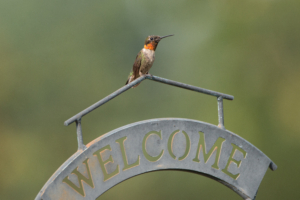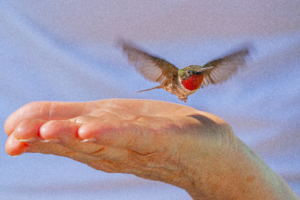How to Invite Hummingbirds to Your Backyard

Article and photos by FMN Barbara Saffir
THEY’RE BAAAACCCCCKKK! Flying fairies — ruby-throated hummingbirds — returned to Virginia in April so now it’s time to invite some to your house or apartment. It’s easy and cheap. Just serve up some irresistible food and an inviting home. That means a clean hummer feeder, native plants, and nearby trees for them to eat, nest, and snuggle in. A water source is a huge plus for all birds and critters, especially to help them survive summer’s searing heat. And it’s also paramount to avoid insecticides in your yard since bugs are the main course and high-octane fuel for these feisty, flying jewels that can beat their wings about 53 times each second, according to Cornell’s respected “All About Birds” website. Ruby-throats are the only hummers that nest east of the Mississippi.
First the flowers. Even if you can’t plant salvia, cardinal flower, bee balm, coral honeysuckle, trumpet vine, or other hummer-magnets in time, or if you live in an apartment with a pint-sized balcony, you can still buy them in containers. It’s best to place them near your hummingbird feeders so they can slurp some sugar water for desert after gobbling down their bug buffet. Cornell says they especially love the bugs that humans sometimes hate, including disease-carrying mosquitoes, gnats, fruit flies, small bees, and spiders. And your local big box store is NOT the ideal place to buy hummer plants. Native plant nurseries appear to be the best sources for hummer-preferred flowers. When you go shopping, if you can, chose the plants with butterflies or hummers already feeding from them. And gobs of other wildflowers and flowering trees seduce hummingbirds, not just the ones you typically hear about. Virginia Tech offers some suggestions below.

Second, the feeders. All you need is a $4 hummingbird feeder (see below) and some plain white
granulated sugar. But NEVER hang any hummingbird feeders unless you’re willing to clean them every couple of days in the heat because dirty ones can form mold, fungus, bacteria, and fermentation, which can hurt or kill your hummers. The National Wildlife Federation says you need to refill the nectar “as often as every two days when summer temperatures remain above 90 degrees F. Rinse the feeder thoroughly—without soap—before refilling. Clean it once a month with a very mild, diluted bleach solution.” It also helps to hang the feeders from a ($4 and up) ant moat to prevent ants from monopolizing the nectar.




Thanks for this hummer article, Barbara!
There is a lot of information about hummingbird feeder nectar but planting the locally native plants that they are attracted to is the best advice. Too many of us do not keep the feeder clean. You can find local ecotype plants at earthsangha.org in Springfield.
I’ve read other articles that warn not to boil the water WITH the sugar because it creates a by-product.
Here’s a link to the Smithsonian’s recipe, which doesn’t call for boiling: https://nationalzoo.si.edu/migratory-birds/hummingbird-nectar-recipe#:~:text=No%2C%20the%20water%20for%20your,fully%20dissolved%20in%20the%20water.
Thank you!